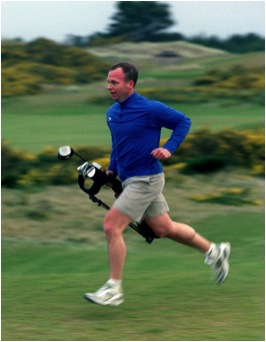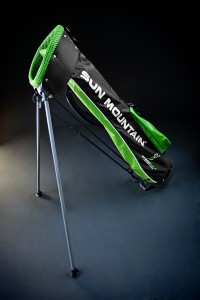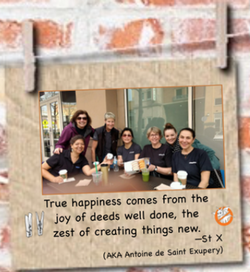This is a re-post of an article which appeared at iGolf.com.
Imagine a world where you could play a swift round of golf, scoring well, while getting a great cardio workout at the same time.
Better yet, imagine watching a televised event where extremely skilled golfers (maybe even PGA Tour Pros), could complete their entire 18-hole round under an hour.
That’d crazy talk, right?
Don’t say that to Tim Scott, the executive director of Speedgolf International. The need for speed (NFS) is something the game of golf has desired for quite some time. In a story by John Paul Newport of The Wall Street Journal (Golf’s Worst Enemy Rears Its Head: Slow Play Is Bad for the Game. How the PGA Tour Could Do Something About It, and Why It Won’t), he pointed out “Survey after survey show that slow play is a major factor in creating ex-golfers.”
Earlier this year, Tiger Woods was noticeably frustrated on how slow the round was at the Farmers Insurance Open that took place at Torrey Pines.
“I started losing my patience out there. It was just so friggin’ slow,” Woods said after posting a final-round 3-under 69.
Not only is there a need for speed, but also a need for a paradigm shift on how the game is approached.
What if you don’t have time to think? What if your score combined the time taken to complete the round with the total strokes taken?
That’s pretty much the gist behind Speedgolf. And if you want to see how it works, make sure to tune into the 30-minute special that CBS is planning on airing before the start of the third round of the Masters (Masters Saturday, April 13, 2013).
What you will see is an edited version of the Inaugural Speedgolf World Championships. The event consisted of 45 amateurs and 15 professionals who competed for a $50K purse. For the professional field it was a 2-day event where they played at Old Macdonald course on Saturday (Oct. 20) and the Bandon Dunes course on Sunday (Oct. 21). The amateurs only ran on Oct. 21 at Bandon Dunes.
The overall winner was Chris Walker with a final score of 263:28. To put that in perspective, on day one he had a score of 77 in 53 minutes and 29 seconds for a total of 130:29. On day two, he was a stroke lower and a few minutes slower at 76 and 56:29.
The runner up was Tim Scott, 264:47 (81-52:21; 80-51:26). And the first woman, Gretchen Johnson, finished 8th overall with a score of 273:38 (84-55:19; 79-55:19).
To get a sense, here are the vitals of each course:
>> Day 1: Old Macdonald from the Black tees is a Par 71 at 6978 yards and a slope rating of 133.
>> Day 2: Bandon Dunes from the Black tees is a Par 72 at 6732 yards and slope rating of 143.
Bandon Dunes, a tough, tough course, is also quite picturesque so it makes a great setting for a televised event (similar to Pebble Beach in that regard).
Stop and ponder those numbers. A fairly decent round of golf under an hour is quite impressive.
The mission of Speedgolf International as stated on their website is to promote the game of Speedgolf, emphasizing faster play, fitness, creativity, fun, and better golf performance.
I had a chance to interview Speedgolf executive director, Tim Scott regarding Speedgolf and this first ever television event.
“Pro Tour of Speedgolf would make a great televised event,” said Mr. Scott. “Quality par golf played in 45-55 minutes. People would watch that.”
Apparently owner of Bandon Dunes and “speedy round” advocate Mike Keiser paved the path to CBS television. You may have read about him. Mr. Keiser made a fortune selling greeting cars on recycled paper, and then turned around and created a golf resort on the southern Oregon coast. The Bandon Dunes Golf Resort attracts wealthy people in private jets from around the world (Source: NY Times: Assisting the Good Life — 15 June 2007).
Mr. Scott told me that Mr. Keiser is a big fan of Speedgolf because of its combination of fast play and exercise. The first Bandon Dunes Speedgolf Classic took place in 2002.
“It’s pretty cool,” said Mr. Scott. “Mike Keiser is really who turned it into what it is, but if we hadn’t kept doing it, this would have never happened.”
Mr. Scott said that he sees Speedgolf as being a catalyst to speed up regular golf. His organization is actively promoting the idea that you don’t have to take forever to play good golf. A “win” is being able to shave 20-30 minutes off per round of “regular” golf. That would definitely draw more people into playing on a regular basis.
How it is played:
Let’s step back and talk about how Speedgolf is played. Competitors generally carry 5-6 clubs in a small bag (Speedgolf International recommends a lightweight, Sun Mountain bag with legs that has been specially designed for Speedgolf), wear athletic golf attire, put on their running shoes (like the Montrail trail running shoes) and they are ready to go.
Speedgolfers play as singles and generally tee off in three-minute intervals. As for the distance, be prepared for approximately five miles of running.
The only real differences from traditional golf are the flagstick is left in when putting and lost balls are dropped anywhere on the line of flight of the previous shot with a one-shot penalty.
As in traditional golf, course care is solely the responsibility of the player. Repairing ball-marks, replacing divots, and raking bunkers are the responsibility of the player. Occasionally, in tournament play with a large volunteer contingent, course care will be taken care of by the volunteers.
Occasionally, in tournament, league, or recreational play, a player will need to play through a slower player ahead of them. The player who is passing has the right of way. A simple “fore” by the passing player lets the player ahead know that he/she must halt play momentarily while the faster player plays through.
The Future of Speedgolf:
Speedgolf International is making its website serve as a gathering spot for Speedgolfers. Mr. Scott told me he has been getting a lot of inquiries about starting leagues. Worth noting is that 30% of the emails are from women.
There is a PowerPoint presentation that Speedgolf International has put together to help pitch leagues to prospective golf courses. The advantages include:
> Attracting approximately one to two dozen players each week (many net new). The number is based on leagues already formed in other cities.
> Speedgolfers play as singles and generally tee off in three-minute intervals for league play. Courses would be able to get more rounds played (and associated fees) by attracting a Speedgolf crowd.
> It wouldn’t disrupt the current members / players because Speedgolfers would play fast rounds at first light or within a couple hours of dusk.
> Speedgolf International will help publicize the league and help attract more players and business for the golf course.
> Speedgolf International is also willing to work with golf course staff to make sure other golfers are aware of the Speedgolf league AND to enable both Speedgolfers and traditional golfers to coexist and have equal enjoyment
Per the Speedgolf International website, leagues have been formed in Portland, Indianapolis, Raleigh, Sacramento, and Prentice (Washington State).
Conclusion:
In the brief period of time I spent being a golf course marshal, my priority was to make sure groups of golfers weren’t “out-of-position.” That meant they had to keep up with the group in front of them. In a Speedgolf conscious world, if everyone was thinking less and playing faster, the rounds would be a lot quicker and more satisfying. Plus, for golf course owners, they would be attracting more golfers playing more frequently. The sounds of cash registers ringing in the Pro Shop would be like music to their ears. And for the ecosystem of golf, more players mean more equipment sold and more time with teaching pros. It’s a “win-win” situation.
But, as Stephen Covey has said early and often, “First things first.”
Make sure you book the time to view, or set your DVR to record this 30-minute special on the Speedgolf World Championship taking place on Masters Saturday. See for yourself what can happen when skilled golfers lace up running shoes and take off on a picturesque and challenging course. I think you’ll agree that this is where the sport needs to go.
##
To learn more, check out Speedgolf International’s website:
http://www.speedgolfinternational.com/













Speak Your Mind